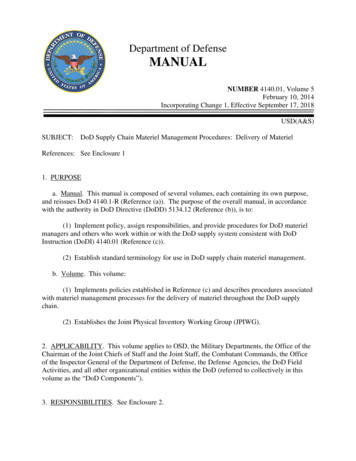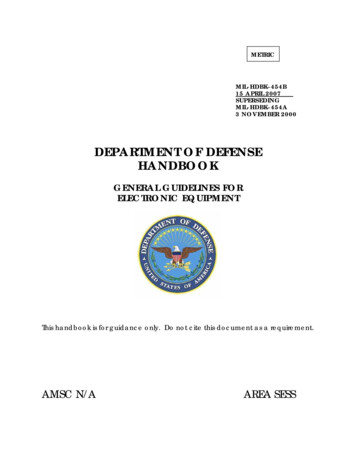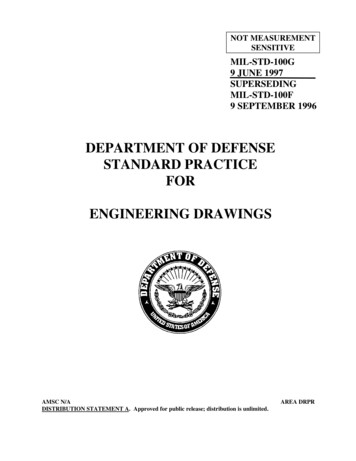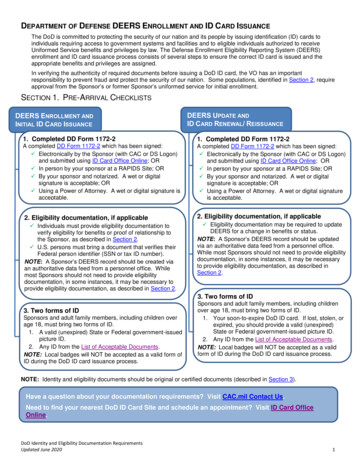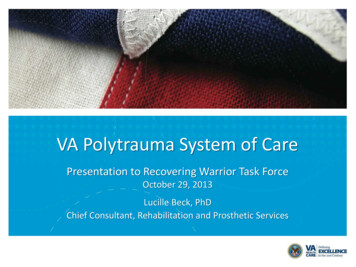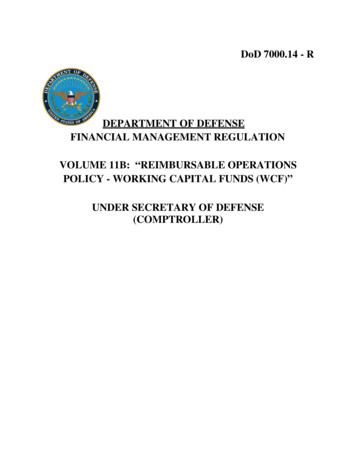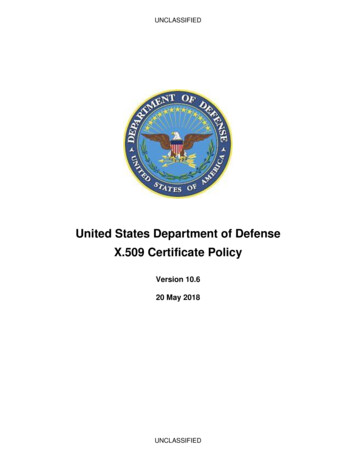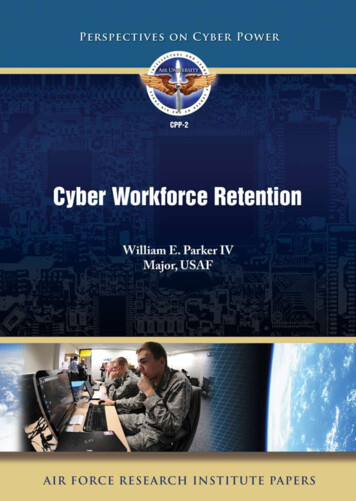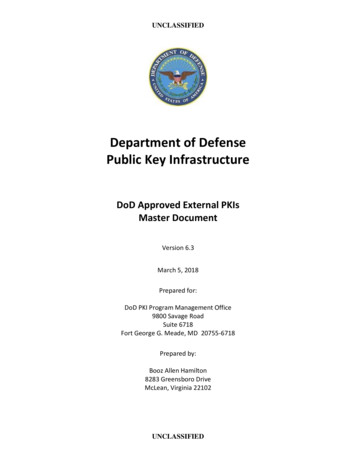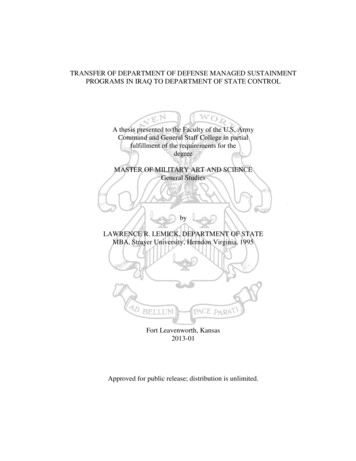
Transcription
TRANSFER OF DEPARTMENT OF DEFENSE MANAGED SUSTAINMENTPROGRAMS IN IRAQ TO DEPARTMENT OF STATE CONTROLA thesis presented to the Faculty of the U.S. ArmyCommand and General Staff College in partialfulfillment of the requirements for thedegreeMASTER OF MILITARY ART AND SCIENCEGeneral StudiesbyLAWRENCE R. LEMICK, DEPARTMENT OF STATEMBA, Strayer University, Herndon Virginia, 1995Fort Leavenworth, Kansas2013-01Approved for public release; distribution is unlimited.
REPORT DOCUMENTATION PAGEForm ApprovedOMB No. 0704-0188Public reporting burden for this collection of information is estimated to average 1 hour per response, including the time for reviewing instructions, searching existing datasources, gathering and maintaining the data needed, and completing and reviewing this collection of information. Send comments regarding this burden estimate or any otheraspect of this collection of information, including suggestions for reducing this burden to Department of Defense, Washington Headquarters Services, Directorate forInformation Operations and Reports (0704-0188), 1215 Jefferson Davis Highway, Suite 1204, Arlington, VA 22202-4302. Respondents should be aware that notwithstandingany other provision of law, no person shall be subject to any penalty for failing to comply with a collection of information if it does not display a currently valid OMB controlnumber. PLEASE DO NOT RETURN YOUR FORM TO THE ABOVE ADDRESS.1. REPORT DATE (DD-MM-YYYY)2. REPORT TYPE3. DATES COVERED (From - To)14-06-2013Master’s ThesisAUG 2012 – JUN 20134. TITLE AND SUBTITLE5a. CONTRACT NUMBERTransfer of Department of Defense Managed SustainmentPrograms in Iraq to Department of State Control5b. GRANT NUMBER5c. PROGRAM ELEMENT NUMBER6. AUTHOR(S)5d. PROJECT NUMBERLawrence R. Lemick5e. TASK NUMBER5f. WORK UNIT NUMBER7. PERFORMING ORGANIZATION NAME(S) AND ADDRESS(ES)8. PERFORMING ORG REPORTNUMBERU.S. Army Command and General Staff CollegeATTN: ATZL-SWD-GDFort Leavenworth, KS 66027-23019. SPONSORING / MONITORING AGENCY NAME(S) AND ADDRESS(ES)10. SPONSOR/MONITOR’SACRONYM(S)11. SPONSOR/MONITOR’S REPORTNUMBER(S)12. DISTRIBUTION / AVAILABILITY STATEMENTApproved for Public Release; Distribution is Unlimited13. SUPPLEMENTARY NOTES14. ABSTRACTUnited States Military Forces Iraq were under the mandate to withdraw from Iraq no later thanDecember 2011. Upon their withdrawal, 16,500 diplomats, security, and support personnelwould remain. The current military sustainment system would transfer to the Department ofState (DoS) known as United States Mission Iraq (USMI). DoS does not normally provide thismagnitude of support to United States (U.S.) personnel at its worldwide locations, nor is itadequately funded to do so. Further complicating this transition was the fact that Iraq was stillconsidered a non-permissive environment. Furthermore, the Iraqi economy was still relativelyimmature, requiring the use of external support sources and personnel to provide sustainment.This study specifically examines the transfer of Class I (Subsistence), Class III (Bulk Fuel) andbase life support services to support the 15 enduring sites within Iraq. This transition from DoDto DoS was unique and served as a true test of interagency cooperation.15. SUBJECT TERMSInteragency, Sustainment, Logistics.16. SECURITY CLASSIFICATION OF:a. REPORTb. ABSTRACTc. THIS PAGE(U)(U)(U)17. LIMITATIONOF ABSTRACT18. NUMBEROF PAGES(U)7519a. NAME OF RESPONSIBLE PERSON19b. PHONE NUMBER (include area code)Standard Form 298 (Rev. 8-98)Prescribed by ANSI Std. Z39.18ii
MASTER OF MILITARY ART AND SCIENCETHESIS APPROVAL PAGEName of Candidate: Lawrence R. LemickThesis Title: Transfer of Department of Defense Managed Sustainment Programs inIraq to Department of State ControlApproved by:, Thesis Committee ChairTimothy H. Civils Jr., M.S., MemberTimothy O’Hagan, M.A., MemberJonathan M. House, Ph.D.Accepted this 14th day of June 2013 by:, Director, Graduate Degree ProgramsRobert F. Baumann, Ph.D.The opinions and conclusions expressed herein are those of the student author and do notnecessarily represent the views of the U.S. Army Command and General Staff College orany other governmental agency. (References to this study should include the foregoingstatement.)iii
ABSTRACTTRANSFER OF DEPARTMENT OF DEFENSE MANAGED SUSTAINMENTPROGRAMS IN IRAQ TO DEPARTMENT OF STATE CONTROL, by Lawrence R.Lemick, 75 pages.United States Military Forces Iraq were under the mandate to withdraw from Iraq no laterthan December 2011. Upon their withdrawal, 16,500 diplomats, security, and supportpersonnel would remain. The current military sustainment system would transfer to theDepartment of State (DoS) known as United States Mission Iraq (USMI). DoS does notnormally provide this magnitude of support to United States (U.S.) personnel at itsworldwide locations, nor is it adequately funded to do so. Further complicating thistransition was the fact that Iraq was still considered a non-permissive environment.Furthermore, the Iraqi economy was still relatively immature, requiring the use ofexternal support sources and personnel to provide sustainment. This study specificallyexamines the transfer of Class I (Subsistence), Class III (Bulk Fuel) and base life supportservices to support the 15 enduring sites within Iraq. This transition from DoD to DoSwas unique and served as a true test of interagency cooperation.iv
ACKNOWLEDGMENTSI would like to express my deepest appreciation to all those who provided me thepossibility to complete this thesis. A special gratitude I give to my Committee Chair Mr.Timothy Civils whose patience and forbearance, with me, providing stimulatingsuggestions and encouragement, which helped me to coordinate my project and develop apolished product. I would also like to express my gratitude and appreciation to my familywho also felt the absence of my presence while working on this project. I appreciate theunderstanding and many days my wife Ana was in the same room but alone because ofmy attention to this project.Furthermore, I would also like to acknowledge with much appreciation the crucialrole of the committee members, Dr Jonathan House and Mr. Timothy O’Hagan who gavethe permission, the grammatical tips and all the required and necessary materials tocomplete the research and thesis. A special thanks goes to my daughter Michel FunesEngleston, who helped me to assemble the parts and gave valuable suggestions about theproject.v
TABLE OF CONTENTSPageMASTER OF MILITARY ART AND SCIENCE THESIS APPROVAL PAGE . iiiABSTRACT. ivACKNOWLEDGMENTS .vTABLE OF CONTENTS . viACRONYMS . viiiILLUSTRATIONS . ixCHAPTER 1 INTRODUCTION .1Background .1Department of State and Department of Defense Interagency Planning .4Department of State Transition Challenges .5Department of Defense Transition Challenges .8Other U.S. Transitions from Military to Host Nation .9Problem Statement .11Research Questions .11Limitations .11Delimitations .12Significance .12CHAPTER 2 LITERATURE REVIEW .13Department of State .13Department of State Service and Support to Embassies .15Department of Defense Title 10 and Department of State Title 22 .17Department of Defense and Combatant Commands.20Department of Defense Global Sustainment .20Defense Logistics Agency .21Defense Contract Management Agency .23U.S. Army Materiel Command .23Operational Contract Support .25Logistics Civil Augmentation Program .27Army Theater Sustainment .28Class I Distribution .28Class III Distribution .29vi
CHAPTER 3 METHODOLOGY .31Introduction .31Questions to Answer .31Approach Used .31How Data was Collected.33Research Strengths .34Research Weaknesses .34Summary .35CHAPTER 4 ANALYSIS .36Department of State Transition Implementation Overview .36The Class I Transfer Concept .38The Class III (B) Transfer Concept .42The Sustainment Services Transfer Concept .45CHAPTER 5 CONCLUSIONS AND RECOMMENDATIONS .49Recommendations for Further Research.52GLOSSARY .53APPENDIX A MISSION IRAQ ACQUISITION STRATEGY ROADMAP 2012TO 2013 .58APPENDIX B DFAC SITES IRAQ .60APPENDIX C REMAINING ENDURING DFACS IRAQ.61BIBLIOGRAPHY .62vii
ACRONYMSAPODAerial Port of DebarkationCOCOMCombatant CommandDCMADefense Contract Management AgencyDFACDining FacilityDLADefense Logistics AgencyDLA-TSDefense Logistics Agency-Troop SupportDoDDepartment of DefenseDoSDepartment of StateFOBForward Operating BaseGAOGeneral Accounting OfficeGSOGeneral Services OfficerLNOLiaison OfficersLOGCAPLogistics Civil Augmentation ProgramSPVSubsistence Prime VendorsTSCTheater Sustainment CommandU.S.United StatesUSAMCUnited States Army Materiel CommandUSMIU.S. Mission Iraqviii
ILLUSTRATIONSPageFigure 1. New Embassy in Baghdad, and the establishment of the Office of SecurityCooperation Iraq sites .3ix
CHAPTER 1INTRODUCTIONBackgroundBy October 1, 2011, the Department will assume full responsibility for theU.S. presence in Iraq, as DoD withdraws its remaining 50,000 troops byDecember 2011, according to the U.S.-Iraq Security Agreement. 1 This withdrawalwill require the Department to provide security, life support, transportation, andother logistical support currently provided by the U.S. military in Baghdad, atconsulates in Basra and Erbil, at embassy branch offices in Kirkuk and Mosul,and at other sites throughout Iraq. 2— Office of the Special InvestigationDepartment of State, May 2011On November 18, 2008, the United States (U.S.) and Iraq signed a landmarkagreement that ended the war in Iraq. The historic agreement consisted of 30 articles,covering all areas in respect of Iraq’s sovereignty, and the continuing diplomatic,military, and internal relationship between the U.S. and Iraq. The articles ranged insubjects from U.S. troop withdrawal, to the way Iraq would govern its judiciary systems,to Iraqi rule of Law, and the status of forces and protections for those U.S. militarypersonnel that were to remain in Iraq and assist in its transition to a civil society. In thatagreement was the requirement that all combat and the majority of support U.S. militarypersonnel and military contractors had to be out of the country by December 31, 2011.1United States of America and the Republic of Iraq, Agreement Between theUnited States of America and the Republic of Iraq on the Withdrawal of United StatesForces from Iraq and the Organization of Their Activities during Their TemporaryPresence in Iraq, November 17, 2008.2Office of Inspector General, MERO-1-II-08, Department of State Planning forthe Transition to a Civilian-led Mission in Iraq, Performance Evaluation (Arlington, VA:Government Printing Office, May 2011), 3.1
On December 1, 2011, all U.S. managed programs would be under Department of State(DoS) control. The basic plan was to build a robust diplomatic and assistance platform inIraq with 15 enduring sites throughout the country, including the construction of two newconsulates and two embassy branch offices. 3 The main embassy would continue to belocated in Baghdad within the recently constructed embassy complex. The remaining 14sites would perform five different functions in support of the unique DoS Iraq mission.First, DoS would establish two embassy branch offices within northern Iraq in the citiesof Mosul and Kirkuk. Second, consular services would be provided by consulate officesin Erbil and Basra. Third, the Office of Security Cooperation Iraq would manage theforeign military sales program from offices in Baghdad, Besmaya, Taji, Tikrit, and UmmQasr. Fourth, DoS would continue to develop and train the Iraqi police forces at sites inBaghdad, Basra, and Erbil. Finally, DoS established air hubs in the cities of Baghdad,Basra, and Erbil with Baghdad International Airport serving as the official air point ofentry for all arriving U.S. personnel supporting the diplomatic mission. The plannedenduring presence locations are depicted in figure 1.3Special Inspector General for Iraq Reconstruction (SIGR), Quarterly Report andSemiannual Report to the United States Congress, July 30, 2012, 12/Report - July 2012.pdf (accessed April 21, 2013).2
Figure 1. New Embassy in Baghdad, and the establishment of the Officeof Security Cooperation Iraq sitesSource: Office of Inspector General, MERO-1-II-08, Department of State Planning forthe Transition to a Civilian-led Mission in Iraq, Performance Evaluation (Arlington, VA:Government Printing Office, May 2011).As of December 31, 2011, all U.S. personnel in Iraq would operate under theauthority of the Chief of Mission, also known as the ambassador, for the execution of alldiplomatic, humanitarian, and security assistance activities. In addition, the U.S.Government had to transition all the remaining bases where it had a presence to the3
Government of Iraq upon withdrawal. 4 There are few precedents or processes uponwhich to draw for providing base operations, life, and logistics systems for a nonDepartment of Defense (DoD) customer. In this instance, DoS needed to not only supportthe Chancery Compound itself, but also any additional enduring remote sites (e.g.,consulate locations) as well as established Office of Security Cooperation sites.The U.S. Congress believed this plan was very ambitious, costly, and unattainablegiven the terms of withdrawal for DoD personnel. The projected amount for thistransition was estimated in excess of a billion dollars in construction costs alone, andmillions more in security. The drawdown was intended to save money, not cost more, andthe American people wanted to stop the flow of many years of exorbitant expenditures.Department of State and Department of DefenseInteragency PlanningIn April 2009, DoS and DoD established an interagency planning effort with theintent that DoS would assume and continue many of the programs and services that DoDused to provide, including support for the Iraqi police training program, designed to buildthe Iraqi police capacity. DoS also planned to expand the U.S. diplomatic presence,which entailed increasing requirements for security, sustainment, and base supportsystems. They formed a “Whole of Government” unified approach that enabled thetransition from a military-centric combat mission, to the end state of a diplomaticsupported mission in support of a sovereign nation. The planning team, called the “Iraq4Government Accountability Office, GAO 11-774, Iraq Drawdown:Opportunities Exist to Improve Equipment Visibility, Contractor Demobilization, andClarity of Post-2011 DoD Role (Washington, DC: Government Accountability Office,September 2011), 3.4
Enduring Presence Working Group,” consisted of DoS and DoD representatives for allfunctions that would transition or be affected by transition. This team met daily in person,as well as via video conferencing and telephonic conference calls. As the planning effortbegan, the working group assumed that there would be a limited DoD presence to assistin the security and operate the checkpoints within Iraq. This assumption proved falsewhen the Iraq Government refused to extend the Status of Forces Agreement, leaving theuniformed soldier without the legal protections under the Uniform Code of MilitaryJustice. Additionally, the working group produced a plan finalizing the number ofdiplomatic and contractor personnel that would remain in country, and upon agreementwith the Government of Iraq, the DoS Iraq Transition Coordinator announced in June2011 that the combined U.S. Government and contractor presence would be limited to amaximum of 16,500 personnel to support the 15 end
MBA, Strayer University, Herndon Virginia, 1995 . Fort Leavenworth, Kansas . 2013-01 . Approved for public releas
